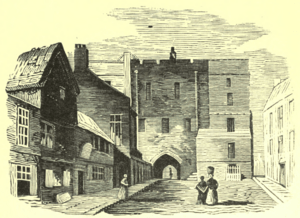New Gate, Newcastle facts for kids
The New Gate was an important old city gate in Newcastle, England. It was part of the Newcastle town walls, which were built a long time ago. For many years, this gate was also used as a prison. Today, a street called Newgate Street is named after it.
Contents
The New Gate: A Look Back
The city of Newcastle had strong walls built in the 1200s and 1300s. The New Gate was part of these walls, located on the northern side. People knew about the New Gate as early as the 1300s. Its name suggests it might have been built where an even older gate once stood. Some historians believe it might have replaced a gate called the Berwick Gate.
What Did the New Gate Look Like?
The oldest part of the New Gate was its south side. It looked similar to the inner part of Alnwick Castle. The north side was designed to protect the main gate. It had galleries on each side, which helped defenders attack anyone trying to get through the first entrance.
On the north side, there were three old shields. One had St. George's cross, another showed the arms of England with many fleurs de lis (a flower symbol), and the third had the arms of Newcastle. Later, a statue of James VI and I was placed above the south side. He was shown wearing a crown and robes, holding a sceptre and a globe.
Why Was the New Gate Taken Down?
By 1820, the New Gate was in bad shape. A group of important people in Newcastle said it was "out of repair" and not safe or big enough for a prison anymore. This led to the decision to build a new prison in a place called Carliol Croft.
People who were in prison for serious crimes were moved to the new prison. Those who were in prison because they owed money were moved to Newcastle Castle.
In June 1823, workers began to pull down the east side of the New Gate. Then they removed the west side, and finally the north side. The very oldest part of the gate was still standing, and some people tried hard to save it. They suggested making roads on each side of the old gateway and turning it into meeting halls.
However, the city leaders did not agree. They wanted the old stones from the gate to help build the new prison. So, in September 1823, parts of the remaining walls were blown up with gunpowder. The rest were easier to remove. The portcullis (a heavy gate that could be lowered) was found in perfect condition. It was moved to Matthew White Ridley, 1st Viscount Ridley's home at Blagdon Hall. During the demolition, workers also found several cannon-balls deep inside the walls.
Images for kids




